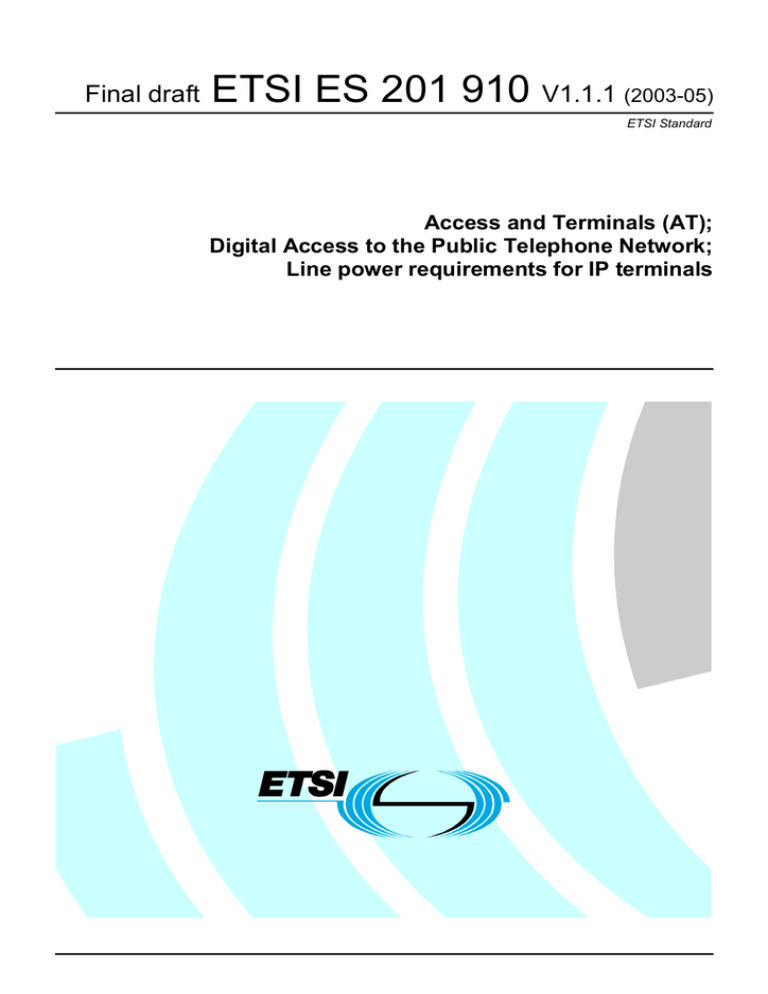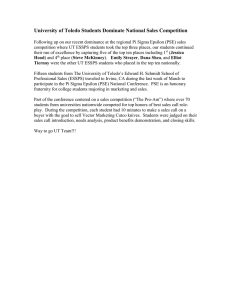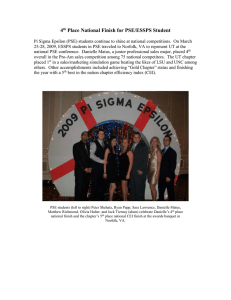
Final draft
ETSI ES 201 910 V1.1.1 (2003-05)
ETSI Standard
Access and Terminals (AT);
Digital Access to the Public Telephone Network;
Line power requirements for IP terminals
2
Final draft ETSI ES 201 910 V1.1.1 (2003-05)
Reference
DES/AT-020013
Keywords
IP, Terminal, LAN
ETSI
650 Route des Lucioles
F-06921 Sophia Antipolis Cedex - FRANCE
Tel.: +33 4 92 94 42 00 Fax: +33 4 93 65 47 16
Siret N° 348 623 562 00017 - NAF 742 C
Association à but non lucratif enregistrée à la
Sous-Préfecture de Grasse (06) N° 7803/88
Important notice
Individual copies of the present document can be downloaded from:
http://www.etsi.org
The present document may be made available in more than one electronic version or in print. In any case of existing or
perceived difference in contents between such versions, the reference version is the Portable Document Format (PDF).
In case of dispute, the reference shall be the printing on ETSI printers of the PDF version kept on a specific network drive
within ETSI Secretariat.
Users of the present document should be aware that the document may be subject to revision or change of status.
Information on the current status of this and other ETSI documents is available at
http://portal.etsi.org/tb/status/status.asp
If you find errors in the present document, send your comment to:
editor@etsi.org
Copyright Notification
No part may be reproduced except as authorized by written permission.
The copyright and the foregoing restriction extend to reproduction in all media.
© European Telecommunications Standards Institute 2003.
All rights reserved.
TM
TM
TM
DECT , PLUGTESTS and UMTS are Trade Marks of ETSI registered for the benefit of its Members.
TM
TIPHON and the TIPHON logo are Trade Marks currently being registered by ETSI for the benefit of its Members.
TM
3GPP is a Trade Mark of ETSI registered for the benefit of its Members and of the 3GPP Organizational Partners.
ETSI
3
Final draft ETSI ES 201 910 V1.1.1 (2003-05)
Contents
Intellectual Property Rights ................................................................................................................................4
Foreword.............................................................................................................................................................4
Introduction ........................................................................................................................................................4
1
Scope ........................................................................................................................................................5
2
References ................................................................................................................................................5
3
Definitions and abbreviations...................................................................................................................5
3.1
3.2
4
Definitions..........................................................................................................................................................5
Abbreviations .....................................................................................................................................................6
Line power specification for IP terminals ................................................................................................6
4.1
4.1.1
4.1.2
4.1.2.1
4.1.2.2
4.1.2.3
4.2
4.2.1
4.2.1.1
4.2.1.2
4.2.1.2.1
4.2.1.2.2
4.2.2
4.2.3
4.2.3.1
4.2.3.2
4.2.4
4.2.5
4.2.5.1
4.2.5.1.1
4.2.5.1.2
4.2.5.2
4.2.5.2.1
4.2.5.2.2
4.2.6
4.3
4.3.1
4.3.2
4.4
Overview ............................................................................................................................................................6
Element requirements ...................................................................................................................................6
Power management mechanism....................................................................................................................6
Power failure ...........................................................................................................................................6
Limited power .........................................................................................................................................6
Power recovery .......................................................................................................................................6
Power Sourcing Equipment (PSE) requirements................................................................................................7
Output power ................................................................................................................................................7
Normal power .........................................................................................................................................7
Limited power .........................................................................................................................................7
Minimum requirement.......................................................................................................................7
Optional requirement.........................................................................................................................7
Back-up power supply ..................................................................................................................................7
Policy Controller requirements .....................................................................................................................7
Minimum requirement ............................................................................................................................7
Optional requirement ..............................................................................................................................8
PSE Controller requirements ........................................................................................................................8
PSE power fail management mechanism......................................................................................................8
At loss of primary PSE power.................................................................................................................8
Minimum requirement.......................................................................................................................8
Optional requirement.........................................................................................................................8
During limited power mode ....................................................................................................................9
Minimum requirement.......................................................................................................................9
Optional requirement.........................................................................................................................9
PSE power recovery......................................................................................................................................9
PD requirements .................................................................................................................................................9
Physical characteristics .................................................................................................................................9
Emergency PD classification ........................................................................................................................9
Safety requirements............................................................................................................................................9
History ..............................................................................................................................................................10
ETSI
4
Final draft ETSI ES 201 910 V1.1.1 (2003-05)
Intellectual Property Rights
IPRs essential or potentially essential to the present document may have been declared to ETSI. The information
pertaining to these essential IPRs, if any, is publicly available for ETSI members and non-members, and can be found
in ETSI SR 000 314: "Intellectual Property Rights (IPRs); Essential, or potentially Essential, IPRs notified to ETSI in
respect of ETSI standards", which is available from the ETSI Secretariat. Latest updates are available on the ETSI Web
server (http://webapp.etsi.org/IPR/home.asp).
All published ETSI deliverables shall include information which directs the reader to the above source of information.
Foreword
This ETSI Standard (ES) has been produced by ETSI Technical Committee Access and Terminals (AT), and is now
submitted for the ETSI standards Membership Approval Procedure.
Introduction
It was decided that ETSI would produce a specification identifying the requirements for IP terminals that are powered
by the LAN network (802.3 data interface or MDI).
In the IEEE specification mentioned in IEEE P802.3af [1], the following is specified:
1)
Characteristics of the power supplied via the 802.3 data interface by the PSE (Power Sourcing Equipment).
The PSE is able to decide whether the PD needs power or not by means of a detection algorithm and PD
signature.
2)
Characteristics of the terminal (PD - Powered Device). Different classes of PDs are defined based on power
consumption. Each PD must present a signature in order to receive power and could optionally present a
signature for classification according to power consumption.
The present document adopts all the physical characteristics of the PSE and the PD as specified in the IEEE
specifications to keep the ETSI specification in line with the IEEE requirements.
Since the specification in IEEE P802.3af [1] does not specify nor address the issue of PSE power supply interruptability
or reliability, the present document includes requirements for a mechanism that will address the provisioning of
emergency power to PDs in situations where the PSE primary power supply fails. This is in addition to the PSE and PD
requirements adopted as per IEEE P802.3af [1].
The intention with the additional requirements is to provide a standard that will bridge the gap that exists in the
reliability of provisioning of power in emergency conditions between:
a)
a traditional PSTN telephony network (where reliable and uninterrupted remote powering is provided); and
b)
a 802.3 network with remote powering of IP terminals (implemented in accordance with IEEE P802.3af [1])
that does not cover the interruptability and reliability of provisioning of power.
With the requirements as specified in the present document a basic mechanism (minimum requirement) is provided that
will make it possible to implement an 802.3 network (with remote powering) and ensure basic operations in power fail
emergency conditions, while optionally an advanced mechanism (optional requirement) is provided to make optimum
use of the PD classifications as specified in the IEEE P802.3af [1].
ETSI
5
1
Final draft ETSI ES 201 910 V1.1.1 (2003-05)
Scope
The present document specifies the requirements for line powering of IP Terminals connected to 802.3 interfaces.
The present document is applicable to IP terminals connected to public networks and to customer premises equipment
providing interfaces for the connection of IP terminals. The present document deals with an existing specification for
powering requirements of IP terminals (see IEEE P802.3af [1]).
IP terminals could range from card readers, line powered security cameras to IP telephone terminals.
The provisioning of power from public networks for IP terminals is also specified.
2
References
The following documents contain provisions which, through reference in this text, constitute provisions of the present
document.
• References are either specific (identified by date of publication and/or edition number or version number) or
non-specific.
• For a specific reference, subsequent revisions do not apply.
• For a non-specific reference, the latest version applies.
Referenced documents which are not found to be publicly available in the expected location might be found at
http://docbox.etsi.org/Reference.
[1]
IEEE P802.3af: "Data Terminal Equipment (DTE) Power via Media Dependent Interface (MDI);
Supplement to: Information technology, Telecommunications and information exchange between
systems, Local and metropolitan area networks, Specific requirements Part 3: Carrier sense
multiple access with collision detection (CSMA/CD) access method and physical layer
specifications".
3
Definitions and abbreviations
3.1
Definitions
For the purposes of the present document, the terms and definitions given in IEEE P802.3af [1] and the following apply:
Powered Device (PD): device that is either drawing power or requesting power by participating in the PD detection
algorithm
NOTE:
A PD may draw some or all of its power from the MDI.
Media Dependant Interface (MDI): the 802.3 data interface where the PD is connected on the one side and where the
power and data is provided on the other side of the interface
Power Sourcing Equipment (PSE): equipment that provides the power to the link section (the link section is the
point-to-point medium connection between an PD and a PSE), equipment that can supply power to the PD
PSE Controller: an element or network management station external to the PSE which performs control functions
Policy Controller: management station that determines which ports receive priority power
ETSI
6
3.2
Final draft ETSI ES 201 910 V1.1.1 (2003-05)
Abbreviations
For the purposes of the present document, the abbreviations defined in IEEE P802.3af [1] and the following apply:
LAN
MDI
PD
PSE
Local Area Network
Media Dependant Interface
Powered Device
Power Sourcing Equipment
4
Line power specification for IP terminals
4.1
Overview
The present document considers the elements that are required, and the methods used to combine these elements into a
mechanism that will ensure that uninterrupted and reliable power is provided to IP terminals connected to an 802.3
network via the MDI.
4.1.1
Element requirements
The technical and functional requirements of four elements are described separately in the present document. In order to
ensure optimum interoperability, the requirements of some of the elements are adopted from the IEEE standard
mentioned in [1]. These are the Powered Device (PD) and the Power Sourcing Equipment (PSE).
The newly defined elements are the PSE Controller and Policy Controller. Although these are described as separate
elements, the intelligence to perform the respective functions could be embedded in the PSE. In certain cases, specific
actions may fulfil the requirements of a Policy or PSE Controller.
4.1.2
Power management mechanism
This clause describes the mechanism used to manage power in the case of failure and or the recovery of the primary
power supply to the PSE. The provision of power to the PDs will be managed by the Policy Controller in conjunction
with the PSE Controller and the PSE. The present document makes provision for the formulation of a powering policy
that may be implemented during power failure. The following conditions are covered.
4.1.2.1
Power failure
In this clause the case of power failure of the primary power supply to the PSE and the provisioning of back-up power
is discussed. Once on back-up power (limited power mode) the available power is managed according to a minimum
requirement and optional advanced requirements. The minimum requirement is based on pre-defining of priority ports
that will receive power during limited power mode. The optional requirements allows the provisioning of power to be
based on a powering policy that utilizes the classification of PDs (according to power consumption) by the PSE in order
to manage back-up power.
4.1.2.2
Limited power
This clause discusses the power management actions of the PSE (in conjunction with PSE Controller and Policy
Controller) while the PSE is in limited power mode. A basic minimum requirement is specified, as well as optional
advanced requirements. Specific events are specified for each of the requirements of power failure management.
4.1.2.3
Power recovery
This clause covers the condition where the primary power to the PSE is restored and power is provided on all ports and
to any classof PD.
ETSI
7
4.2
Final draft ETSI ES 201 910 V1.1.1 (2003-05)
Power Sourcing Equipment (PSE) requirements
All physical characteristics of the PSE will be in accordance with IEEE P802.3af [1], unless specifically mentioned.
4.2.1
4.2.1.1
Output power
Normal power
During normal power provisioning, the provision of power shall be in accordance with IEEE P802.3af [1].
4.2.1.2
Limited power
The PSE is considered to be in the limited power mode when primary power supply to the PSE has failed and the PSE is
powered by a back-up power supply.
4.2.1.2.1
Minimum requirement
During limited power, power shall be provided on ports designated as emergency only.
4.2.1.2.2
Optional requirement
The PSE shall provide enough power on each port, that could be permanently or temporarily designated as emergency,
to power a pre-selected class of PD in accordance with a powering policy to be implemented by the Policy Controller.
The present document does not define the powering policy that is used to select or determine the number or the class of
PDs that are to be supplied with power, or not.
If, in an emergency situation, the PSE power is derived from a source in other networks, for which other more
restrictive emergency conditions/regulations/standards apply, then it may not be possible for the PSE to comply with the
present document.
4.2.2
Back-up power supply
In order to maintain a limited supply of power to PDs required to function in an emergency power situation (when the
primary power to the PSE fails), it is necessary that the PSE is backed up by an emergency power unit,
batteries/generator.
The back-up power supply is brought into use when the normal supply to the PSE fails. The backup supply may not be
able to supply the full load and/or may be available for a duration limited by battery or fuel tank capacity. The PSE
Controller may be able to determine an estimate of the remaining capacity.
The present document does not define the type of back-up power.
The present document does not define the time period that back-up power must be provided.
4.2.3
Policy Controller requirements
The Policy Controller is a management station that determines which ports receive priority power.
4.2.3.1
Minimum requirement
During system commissioning, emergency ports that must continue to receive power in the case of failure of primary
power supply (to the PSE), shall be designated.
ETSI
8
4.2.3.2
Final draft ETSI ES 201 910 V1.1.1 (2003-05)
Optional requirement
The Policy Controller may implement a powering policy that utilizes the classification of PDs (according to power
consumption) to decide what class (es) of PDs are to be powered during limited power mode, and on which ports.
The present document does not define whether the association is with user (wherever his number is call forwarded to),
terminal telephone number, terminal IP address, or physical port number. The Policy and PSE Controllers must be able
to map (whether automatically or by manual input) between the physical port and the IP address of the device on that
port, and handle the case of a subsidiary (possibly unmanaged) hub being connected to a port.
-
The port to address mapping is required if priority terminals are defined by physical port.
-
The address to port mapping is required if priority terminals are defined by IP address.
The Policy Controller must be able to maintain the list detailing which of the ports are permanently or temporarily
assigned as normal ports and which are assigned as emergency ports. The Policy Controller must be able to maintain a
list detailing what classes of PDs are to be powered. This includes the accepting, deleting and updating of entries into
the list.
The present document does not define how the Policy Controller must accept, maintain or update a list detailing which
ports under its control are emergency and which are normal, or what classes of PDs are to be powered.
4.2.4
PSE Controller requirements
The PSE Controller is an element or network management station external to the PSE that performs control functions.
The intelligence could however be embedded in the PSE.
The functions of the PSE can include, but are not limited to:
•
Instructs the PSE to switch off/on power to the PDs.
•
Monitor power fail.
•
Monitor power recovery.
4.2.5
4.2.5.1
PSE power fail management mechanism
At loss of primary PSE power
When the normal power supply to the PSE fails (or on command from the PSE Controller), the PSE must switch to
limited power mode. The time period that elapses after the power has failed and before the PSE switches to limited
power mode is not specified. When the PSE is in limited power mode, the PSE Controller must manage and distribute
available power to the PDs as follows:
NOTE:
4.2.5.1.1
When power is removed from the MDI, then data should not be switched off. PDs that rely on their
own (local) power or alternate power sources must still be able to continue operating.
Minimum requirement
Remove power on ports not designated as emergency. Provide power on all ports designated as emergency.
4.2.5.1.2
Optional requirement
Remove or provide power to PDs and on ports in accordance with the powering policy.
ETSI
9
4.2.5.2
4.2.5.2.1
Final draft ETSI ES 201 910 V1.1.1 (2003-05)
During limited power mode
Minimum requirement
When a PD is plugged in on a port not designated as emergency, then no power is provided. When a PD is plugged into
a port designated as emergency, then power shall be provided.
4.2.5.2.2
Optional requirement
When a PD is plugged in on a port, power is initially provided in order for the PSE to do a PD detection. Power shall
then continue to be provided or removed according to the powering policy.
4.2.6
PSE power recovery
When the normal power supply to the PSE recovers, the PSE must exit the limited power mode and restore power to all
ports as per the normal power mode where provisioning of power shall be in accordance with IEEE P802.3af [1].
The time period that elapses after the primary power to the PSE has been restored and before the PSE exits the limited
power mode is not specified.
4.3
PD requirements
A PD is a device drawing some or all of its power from the MDI. In the context of the present document the device will
normally be an IP telephone, but could also be an access control card reader, a security camera, or a portable music
player that recharges its batteries while downloading the day's music. IP telephones could include address book, Web
browser, and multimedia functions.
4.3.1
Physical characteristics
All the physical characteristics of a PD shall be according to IEEE P802.3af [1].
4.3.2
Emergency PD classification
During limited power mode, PDs connected to emergency ports will be powered.
In a power emergency situation, and depending on the powering policy implemented according to the advanced power
fail management option, the supplier of the power may choose to supply only a specific class of PD and disconnect
other classes of PDs.
In order to reduce PD consumption to a minimum, the powering policy may determine that only Class 1 PDs shall be
powered. In this case the owner/user of an IP telephone that is required to remain operational under power emergency
conditions must select a Class 1 PD. If a Class 1 PD cannot be selected, then local power must be provided.
Should the powering policy determine that only a specific class of PD is to be powered, then the PD may reduce power
consumption to a different class as soon as local power failure is detected. Should the powering policy determine that a
specific port(s) must remain operational, irrespective of the power consumption, then the owner/user of an IP telephone
that is required to remain operational under power emergency conditions, need not select a Class 1 PD as an emergency
PD, since all PD classes will be powered when connected to a port assigned as emergency.
The present document attempts to support devices which normally operate from a local power supply or the MDI in a
higher classbut which can switch (automatically or manual) to a lower class possibly with limited functionality.
4.4
Safety requirements
There are no safety requirements in the present document. Safety standards are published by CENELEC.
ETSI
10
Final draft ETSI ES 201 910 V1.1.1 (2003-05)
History
Document history
V1.1.1
May 2003
Membership Approval Procedure
ETSI
MV 20030718: 2003-05-20 to 2003-07-18



